RV Smarter with FMCA
Get RVing Tips & How-To Advice from RV Industry Experts
Having RV troubles on the road? Looking for top-notch tips on winterizing your RV or tackling repairs?
FMCA has got you covered with FMCA University—your ultimate online hub for all things RVing! As a member, you get exclusive access to this treasure trove of RV resources 24/7, from anywhere.
Here’s what you’ll find:
- A Goldmine of Knowledge: Dive into decades of RV wisdom in one convenient spot.
- Expert Insights: Get tips and tricks from the RV industry’s best, including the legendary “RV Doctor” Gary Bunzer.
- Flexible Learning: Browse topics or search for specific issues at your own pace.
- Interactive Content: Enjoy articles, videos, and quizzes to test and expand your RV know-how.
- Badges & Rewards: Earn virtual badges and even become an “RVer Extraordinaire” with a complimentary year of membership.
With FMCA University, you can confidently tackle any RV challenge and have fun while doing it. Your journey to becoming an RV pro starts here!
For more info, just log in to FMCA University through your member portal. Safe travels and happy RVing!
Tire Pressure Monitoring Systems (Article 786)
- Lessons
- Miscellaneous
- Uncategorized Articles
- (Technical)
 A TPMS can help RVers avoid the dangers of underinflated and overheated tires. By Mark Quasius, F333630 October 2019 RV tires perform best when inflated to the proper air pressure. When tires operate at pressures below what is required to carry their load safely, they overheat, which can lead to catastrophic failure. That’s why every RV should have a tire pressure monitoring system, or TPMS. You can, of course, check tire pressures daily with a quality tire pressure gauge. Those checks should be done in the morning when the tires are cold, because tires heat up when they are driven, which affects the pressure readings. But while this is a good practice, you might still lose pressure while you’re driving, such as when your tire meets a nail. If there’s a slow loss of pressure, the tire will heat up, increasing the possibility of failure. In such cases, a TPMS will detect the drop in pressure.
A TPMS can help RVers avoid the dangers of underinflated and overheated tires. By Mark Quasius, F333630 October 2019 RV tires perform best when inflated to the proper air pressure. When tires operate at pressures below what is required to carry their load safely, they overheat, which can lead to catastrophic failure. That’s why every RV should have a tire pressure monitoring system, or TPMS. You can, of course, check tire pressures daily with a quality tire pressure gauge. Those checks should be done in the morning when the tires are cold, because tires heat up when they are driven, which affects the pressure readings. But while this is a good practice, you might still lose pressure while you’re driving, such as when your tire meets a nail. If there’s a slow loss of pressure, the tire will heat up, increasing the possibility of failure. In such cases, a TPMS will detect the drop in pressure.
Internal and external sensors
A number of TPMS kits are available. In general, sensors on each wheel position communicate with a monitor in the cockpit to provide a warning to the driver when a tire falls below a set pressure threshold. Sensors are attached either internally or externally to the wheels and communicate wirelessly with the cockpit monitor. Some companies offer external flow-through sensors, which allow you to inflate the tires without removing the sensors from the valve stems. Many sensors provide tire temperature as well as pressure information. Most systems can monitor a motorhome’s tires as well as the towed vehicle’s tires. If you own a towable RV and your truck is equipped with a factory-installed TPMS, it won’t work with your RV. You’ll need a system designed to monitor the RV. An internal sensor mounts to the inside of the wheel rim and may incorporate its own valve stem. This type is used on virtually all cars and light trucks manufactured today. Some internal sensors are mounted on a large band clamp that wraps around the inside of the wheel. External sensors, which screw onto the outside of existing valve stems, generally don’t interfere with a factory TPMS. External sensors require metal (rigid) valve stems, so if your towed vehicle has rubber valve stems, you must replace them. If you don’t, centrifugal force from the external sensor can flex the valve stem, causing it to leak and eventually fail. Many aftermarket external sensors have a theft-resistant feature, although it’s unclear how many such thefts occur. External sensors can be subject to damage, especially when installed on a vehicle you take off-roading. Internal sensors are inherently theft-proof and damage-resistant, but they have a higher installation cost, because the tires must be removed, and after the sensors are installed, the tires/wheels must be rebalanced. If your vehicle already has a factory-installed TPMS, you won’t be able to use it once you add aftermarket RV sensors. Fortunately, some aftermarket systems allow a second monitor to be placed in the towed vehicle so the aftermarket TPMS can be used when that vehicle is driven away from the motorhome.
Tire Temperatures
The temperature of a properly inflated tire may rise by 20 to 60 degrees Fahrenheit when a vehicle is driven, and that’s normal. However, the temperature of an underinflated tire can be much higher. Inadequate air pressure causes the layers or plies in the tire to flex, creating heat. The tires may overheat to the point where reversion can occur, which returns the rubber to its soft, uncured state. Most aftermarket tire monitoring systems alert users when temperatures reach 160 degrees Fahrenheit to 175 degrees Fahrenheit. When a warning is triggered, you should stop and learn why. Normally, if the rise in temperature is a result of pressure loss, the TPMS will alert you to the pressure problem before the temperature ever approaches a warning level. In such a case, having a TPMS system that monitors temperature is redundant. However, at times other factors can contribute to a serious rise in temperature. In fact, I experienced an incident that underscores the benefits of a TPMS with temperature monitoring. We had just left our campsite in Custer State Park in South Dakota with the motorhome towing our Jeep Wrangler. We had driven about 30 minutes when suddenly the TPMS sounded a warning. I pulled over and found that our Jeep’s rear tires had triggered a temperature alert at 175 degrees. The pneumatic breakaway solenoid had failed on our supplemental braking system, and the air pressure was causing the Jeep’s rear brakes to drag. Without a high-temperature alert, I never would have known, because the air pressure in the tires was fine. Continuing to drive could have overheated the tires to the point of reversion, and they would have failed. It’s also possible the brake fluid could have caught fire. Since then, I have always vowed to have a TPMS with temperature monitoring.
A Sampling Of TPMS Products
Advantage PressurePro LLC, C13523*
(816) 887-3505 www.advantagepressurepro.com
Pulse
 Sensors: External; can monitor up to five vehicles and up to 80 wheel positions. Transmitter batteries: Nonreplaceable; life expectancy is five years. Components are sealed for protection from all environments and to reduce the possibility of sensor failure from overtightening or not being tight enough. Screen display: 2.7-inch (diagonal) color OLED. Alerts for: Pressure and temperature. Pressure range: 8 psi to 215 psi. Other features: The unit, powered by a hardwired cord, can be used on either 12-volt or 24-volt systems. Built-in data logging capabilities offer up to 45 days of temperature and pressure history with PressurePro’s free management software via RS232, which also allows tethering to other RS232 devices. Changing setups or switching between different towed vehicles is a two-button operation. MSRP: Approximately $600 for a four-wheel unit; additional sensors $100 per pair.
Sensors: External; can monitor up to five vehicles and up to 80 wheel positions. Transmitter batteries: Nonreplaceable; life expectancy is five years. Components are sealed for protection from all environments and to reduce the possibility of sensor failure from overtightening or not being tight enough. Screen display: 2.7-inch (diagonal) color OLED. Alerts for: Pressure and temperature. Pressure range: 8 psi to 215 psi. Other features: The unit, powered by a hardwired cord, can be used on either 12-volt or 24-volt systems. Built-in data logging capabilities offer up to 45 days of temperature and pressure history with PressurePro’s free management software via RS232, which also allows tethering to other RS232 devices. Changing setups or switching between different towed vehicles is a two-button operation. MSRP: Approximately $600 for a four-wheel unit; additional sensors $100 per pair.
Pulse FX
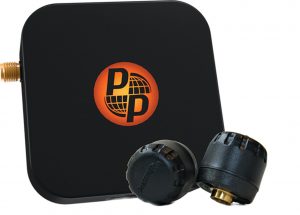 Sensors: External; can monitor up to five vehicles and up to 80 wheel positions. Transmitter batteries: Nonreplaceable; see Pulse battery info above. Screen display: Utilizes a smart device. Alerts for: Pressure and temperature. Pressure range: 8 psi to 200 psi. Other features: Designed originally for towables, the Pulse FX also can be used with motorhomes. It utilizes any Android or iOS smartphone or tablet. It’s useful for a towing vehicle that switches between a towable RV and a boat trailer or other towed vehicle; the system has multiple memory profiles and names for every trailer. A Bluetooth unit plugs into a 12-volt power outlet and has a remote antenna, which usually is cabled to the rearview mirror area. MSRP: $250 for a two-wheel system; additional sensors $100 per pair.
Sensors: External; can monitor up to five vehicles and up to 80 wheel positions. Transmitter batteries: Nonreplaceable; see Pulse battery info above. Screen display: Utilizes a smart device. Alerts for: Pressure and temperature. Pressure range: 8 psi to 200 psi. Other features: Designed originally for towables, the Pulse FX also can be used with motorhomes. It utilizes any Android or iOS smartphone or tablet. It’s useful for a towing vehicle that switches between a towable RV and a boat trailer or other towed vehicle; the system has multiple memory profiles and names for every trailer. A Bluetooth unit plugs into a 12-volt power outlet and has a remote antenna, which usually is cabled to the rearview mirror area. MSRP: $250 for a two-wheel system; additional sensors $100 per pair.
Doran Manufacturing LLC, C10104*
(866) 816-7233 https://doranmfg.com
360RV

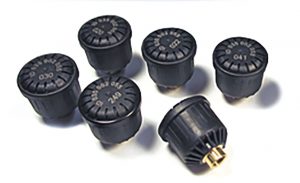 Sensors: External; can monitor up to two vehicles and up to 36 wheel positions. Optional sensor locks are available. Transmitter batteries: Lithium-ion, with an expected life of up to five years. The sensors are spin-welded and the components are encapsulated to protect against vibration, temperature change, and impact, so the batteries are not replaceable. However, replacement sensors can be programmed easily. Screen display: 3.7-inch (diagonal) one-color LCD. A prewired 12-volt plug is included. Alerts for: Pressure and temperature. Pressure range: 10 psi to 188 psi. Other features: The system’s FastLeak alert is triggered when pressure in a tire drops by at least 4.5 psi in less than 16 seconds. The signal’s reach can be improved with an optional interior signal booster or an optional remote antenna kit. The system is designed for two vehicles, and monitoring of one vehicle can be turned off as needed. MSRP: $299.99 for the 360RV4 (four-wheel system); additional sensors are $49.99.
Sensors: External; can monitor up to two vehicles and up to 36 wheel positions. Optional sensor locks are available. Transmitter batteries: Lithium-ion, with an expected life of up to five years. The sensors are spin-welded and the components are encapsulated to protect against vibration, temperature change, and impact, so the batteries are not replaceable. However, replacement sensors can be programmed easily. Screen display: 3.7-inch (diagonal) one-color LCD. A prewired 12-volt plug is included. Alerts for: Pressure and temperature. Pressure range: 10 psi to 188 psi. Other features: The system’s FastLeak alert is triggered when pressure in a tire drops by at least 4.5 psi in less than 16 seconds. The signal’s reach can be improved with an optional interior signal booster or an optional remote antenna kit. The system is designed for two vehicles, and monitoring of one vehicle can be turned off as needed. MSRP: $299.99 for the 360RV4 (four-wheel system); additional sensors are $49.99.
EEZ RV Products LLC, C11163*
(928) 317-8899 https://eezrvproducts.com
EezTire TPMS
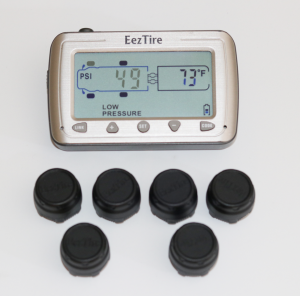 Sensors: External; can monitor up to two vehicles and up to 26 wheel positions; antitheft design; standard and flow-through sensors are available. Transmitter batteries: CR1632; replaceable by the owner. Screen display: 3.5-inch (diagonal) black-and-white LCD with a built-in rechargeable lithium battery. A hardwired cable is included. Alerts for: Pressure and temperature. Pressure range: Up to 210 psi. Other features: A booster/repeater is available to overcome electronic interference and distance challenges. The towed vehicle can be dropped from the system and picked back up when connected. MSRP: $259 for a four-tire system; other systems range up to $839.
Sensors: External; can monitor up to two vehicles and up to 26 wheel positions; antitheft design; standard and flow-through sensors are available. Transmitter batteries: CR1632; replaceable by the owner. Screen display: 3.5-inch (diagonal) black-and-white LCD with a built-in rechargeable lithium battery. A hardwired cable is included. Alerts for: Pressure and temperature. Pressure range: Up to 210 psi. Other features: A booster/repeater is available to overcome electronic interference and distance challenges. The towed vehicle can be dropped from the system and picked back up when connected. MSRP: $259 for a four-tire system; other systems range up to $839.
Intelligent Vehicle Products, C10349*
(562) 926-7123 www.tiresafeguard.com
Tire-Safeguard
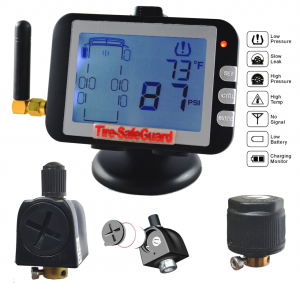 Sensors: Internal rim-mounted, internal valve-mounted, external cap, and external flow-through are available. Can monitor up to 20 wheel positions. The external sensors have antitheft locking screws. Transmitter batteries: Internal sensors — not owner replaceable, said to last five-plus years; external sensors — owner replaceable. Screen display: 3 inches (diagonal) black-and-white LCD powered by a rechargeable battery; a power cord jack is included. The monitor can display one or two screens, and each screen has up to 20 wheel positions. Alerts for: Temperature and pressure. Pressure range: 0 to 199 psi. Other features: The user can take the monitor along when refilling air and see the current pressure readings from the screen. MSRP: $279 for a six-tire system; $459 for a 10-tire system. Other systems also available.
Sensors: Internal rim-mounted, internal valve-mounted, external cap, and external flow-through are available. Can monitor up to 20 wheel positions. The external sensors have antitheft locking screws. Transmitter batteries: Internal sensors — not owner replaceable, said to last five-plus years; external sensors — owner replaceable. Screen display: 3 inches (diagonal) black-and-white LCD powered by a rechargeable battery; a power cord jack is included. The monitor can display one or two screens, and each screen has up to 20 wheel positions. Alerts for: Temperature and pressure. Pressure range: 0 to 199 psi. Other features: The user can take the monitor along when refilling air and see the current pressure readings from the screen. MSRP: $279 for a six-tire system; $459 for a 10-tire system. Other systems also available.
Minder Research Inc., C12082*
(772) 463-6522 www.minderresearch.com 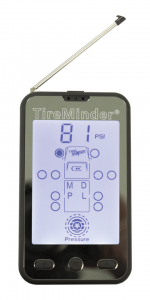
TireMinder A1A
Sensors: External; can monitor two vehicles and up to 22 wheel positions; sensors are secured with Allen-screw antitheft locking rings. Transmitter batteries: CR1623; replaceable by the owner; free replacement until 2022. Screen display: 3.25-inch (diagonal) black-and-white LCD. Alerts for: Pressure and temperature. Pressure range: 0 to 232 psi. Miscellaneous: Checks for tire problems every six seconds and instantly warns of unstable conditions. Sensor reading updates occur every four minutes. A temporary disconnect mode separates a towing vehicle from a towed vehicle. The kit includes a signal booster. MSRP: $399 for a four-tire system; $469 for a six-tire system. 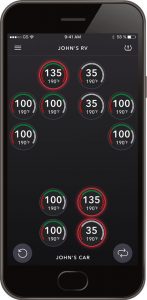
TireMinder Smart TPMS
Much the same as the A1A but differs in that the system sends monitoring information to a smart device (iOS or Android) via Bluetooth Low Energy technology. MSRP: $369 for a four-tire system; $439 for a six-tire system. 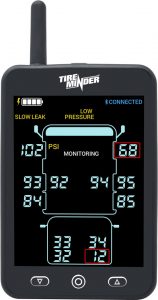
TireMinder A1A-S
Expected to be available November 2019. Features will include a 5.5-inch (diagonal) color screen that displays 22 tires; an upgraded antenna; Bluetooth-enabled so it can communicate with the TireMinder app on a smartphone. MSRP: $449 for a four-tire system; $499 for a six-tire system.
RV Safety Accessories Inc., C10135*
(866) 200-9773 www.tiretraker.com
TireTraker TPMS TT-600
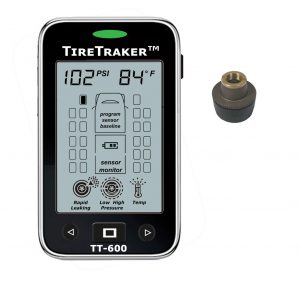 Sensors: External; can monitor up to two vehicles and up to 22 wheel positions. Transmitter batteries: CR1632, replaceable by the owner. Screen display: 2¾-inch (diagonal) black-and-white LCD display with a built-in antenna. The monitor’s rechargeable battery holds a charge for up to 30 days; a dedicated micro-USB-compatible charger is included. Alerts for: Pressure and temperature. Pressure range: 0 to 232 psi. Other features: The system goes into sleep mode after 15 minutes with no motion to conserve battery life. All systems include the new high-power TT-200 signal booster. TireTraker has a lifetime warranty. MSRP: Ranges from $249 to $599. A six-wheel system is $319; a 10-wheel system is $459.
Sensors: External; can monitor up to two vehicles and up to 22 wheel positions. Transmitter batteries: CR1632, replaceable by the owner. Screen display: 2¾-inch (diagonal) black-and-white LCD display with a built-in antenna. The monitor’s rechargeable battery holds a charge for up to 30 days; a dedicated micro-USB-compatible charger is included. Alerts for: Pressure and temperature. Pressure range: 0 to 232 psi. Other features: The system goes into sleep mode after 15 minutes with no motion to conserve battery life. All systems include the new high-power TT-200 signal booster. TireTraker has a lifetime warranty. MSRP: Ranges from $249 to $599. A six-wheel system is $319; a 10-wheel system is $459.
Tire Protector USA, C1238*
(800) 659-6339 www.tireprotectorusa.com
Tire-Protector
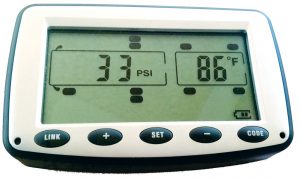 Sensors: External cap-style or external flow-through; antitheft locking collar; can monitor up to 22 wheel positions. Transmitter batteries: CR1632; replaceable by the owner. Screen display: 3.5-inch (diagonal) black-and-white LCD. Alerts for: Pressure and temperature. Pressure range: 8 to 188 psi. Other features: The sensors detect tire pressure and temperature readings every five seconds and transmit data to the monitor every six minutes. A loss of pressure or rise in temperature immediately triggers an alert; the monitor can be placed in the towed car when it is driven. MSRP: $440 for a 10-tire system.
Sensors: External cap-style or external flow-through; antitheft locking collar; can monitor up to 22 wheel positions. Transmitter batteries: CR1632; replaceable by the owner. Screen display: 3.5-inch (diagonal) black-and-white LCD. Alerts for: Pressure and temperature. Pressure range: 8 to 188 psi. Other features: The sensors detect tire pressure and temperature readings every five seconds and transmit data to the monitor every six minutes. A loss of pressure or rise in temperature immediately triggers an alert; the monitor can be placed in the towed car when it is driven. MSRP: $440 for a 10-tire system.
Truck System Technologies Inc., C12907*
(770) 889-9102 www.tsttruck.com
507 Series
 Sensors: Internal, external, cap, and flow-through sensors are available; can monitor up to 115 wheel positions, including a towing vehicle and four trailers or towed vehicles; theft-resistant. Transmitter batteries: Sealed lithium-ion (for internal sensors); CR1632 or CR2032 (for the RV cap and flow-through sensors) are replaceable by the owner. Screen display: 3.5-inch (diagonal) full-color or one-color display powered by a rechargeable lithium-ion battery; power also can be provided by a cord to a USB or a 12-volt receptacle. Alerts for: Pressure and temperature. Pressure range: 0 to 218 psi. Miscellaneous: The unit has a built-in antenna; a remote extender (included) expands the operating range. A trailer or towed vehicle can be removed temporarily from the display when they are not being towed. MSRP: The TST-507-RV-4-C (a four-tire cap system with color display) is $349. Other kits range from $219 to $915. *FMCA commercial member
Sensors: Internal, external, cap, and flow-through sensors are available; can monitor up to 115 wheel positions, including a towing vehicle and four trailers or towed vehicles; theft-resistant. Transmitter batteries: Sealed lithium-ion (for internal sensors); CR1632 or CR2032 (for the RV cap and flow-through sensors) are replaceable by the owner. Screen display: 3.5-inch (diagonal) full-color or one-color display powered by a rechargeable lithium-ion battery; power also can be provided by a cord to a USB or a 12-volt receptacle. Alerts for: Pressure and temperature. Pressure range: 0 to 218 psi. Miscellaneous: The unit has a built-in antenna; a remote extender (included) expands the operating range. A trailer or towed vehicle can be removed temporarily from the display when they are not being towed. MSRP: The TST-507-RV-4-C (a four-tire cap system with color display) is $349. Other kits range from $219 to $915. *FMCA commercial member





